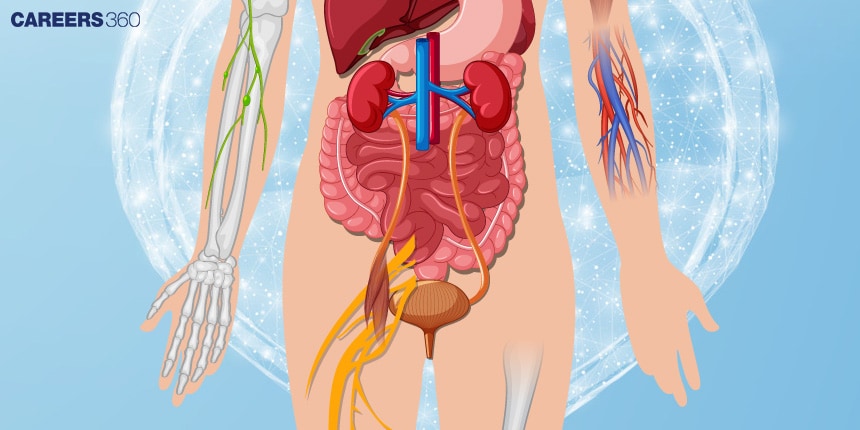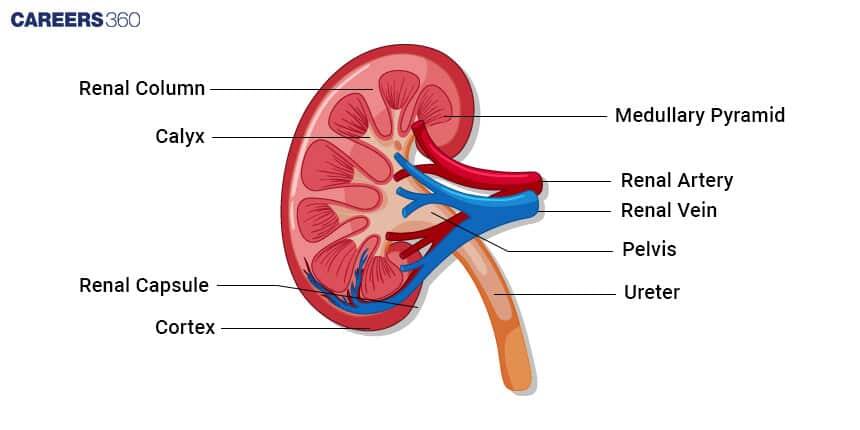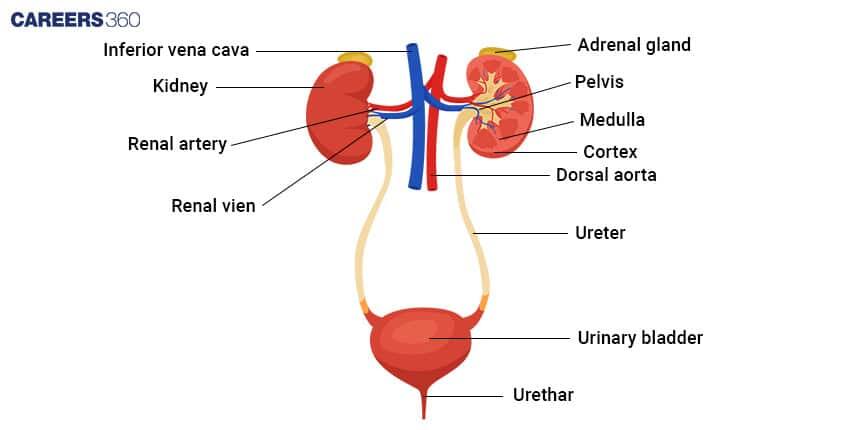Human Excretory system: Definition, Diagram, Function
The human excretory system is one of the important biological systems that ensures waste products leave the body, thus maintaining homeostasis. This system is made up of several excretory organs: the kidneys, ureters, urinary bladder, and urethra. They all work to remove the wastes in the form of nitrogenous wastes, excess salts, and water. The excretory system of human beings primarily acts through the kidneys, as they contain nephrons, the structural and functional units that filter blood to form urine. This is an important part of the Excretory Products and Their Elimination Chapter of Biology.
Don't Miss: Most scoring concepts for NEET | NEET papers with solutions
NEET 2025: Syllabus | PYQs | Crack NEET in 2 months - Study Plan
NEET Important PYQ & Solutions: Physics | Chemistry | Biology | NEET PYQ's (2015-24)
- The Human Excretory System
- Parts of the Human Excretory System
- The Process of Urine Formation
- Regulation of Kidney Function
- Disorders of the Excretory System
- Recommended Video On ‘Human Excretory System’

The Human Excretory System
The human excretory system is an important physiological system, responsible for carrying out an activity of the disposal of waste products and excess substances from the circulatory bloodstream. This helps to keep the constancy of the internal environment of the body. This consists of four organs the kidneys, the ureters, the urinary bladder, and the urethra, all functioning together in blood filtration and the resulting urine production and its elimination from the body.
Excretion is critical to homeostasis since it restores the conditions for the body's interior. Conditions for the volume and composition of body fluids, which in turn establishes blood pressure, electrolyte balance, and acid-base balance are thus maintained with the exact conditions needed to function at the cellular and consequently the health levels.
Also Read:
Parts of the Human Excretory System
The human excretory system contains important parts with varied excretory functions.
Kidneys
The kidneys are complex organs with several distinct structures, each serving a specific function in the filtration and excretion process:
Renal Capsule
Tough, fibrous outer layer that serves to protect the kidney.
Cortex
The outer region of the kidney contains glomeruli and convoluted tubules.
Site of ultrafiltration and initial stages of urine formation.
Medulla
The inner region consists of renal pyramids and renal columns.
It contains the loops of Henle and collecting ducts.
Renal Pyramids
Triangular-shaped structures within the medulla.
It contains nephron loops and collecting ducts that transport urine to the calyces.
Renal Columns
Bands of cortical tissue that separate the renal pyramids.
Provide support for the passage of blood vessels through the kidney.
Nephrons
The microscopic functional units of the kidney. Each nephron is made up of a renal corpuscle and renal tubule.
There are approximately 1 million nephrons per kidney.
Renal Corpuscle
It is made up of glomerulus and Bowman's capsule.
It is the first site of blood filtration.
Glomerulus
A network of capillaries in which the blood filtration takes place.
It is enclosed by Bowman's capsule.
Bowman's Capsule
A cup-like structure that surrounds the glomerulus, collects the filtrate from the blood.
Proximal Convoluted Tubule (PCT)
The first segment is for the renal tubule.
Reabsorbs water, ions and nutrients back from the filtrate.
Loop of Henle
The U-shaped part of the renal tubule extends into the medulla.
Responsible for concentrating urine by reabsorbing water and salt.
Distal Convoluted Tubule (DCT)
The last segment of the renal tubule is before the collecting duct.
Further reabsorption and secretion of ions.
Collecting Ducts
Ducts receive urine from several nephrons.
Transport urine to the renal pelvis.
Renal Pelvis
A funnel-shaped cavity collects urine from collecting ducts.
Channels urine into the ureter.
Renal Artery
Supplies the kidney with blood.
Branches further into smaller arterioles, which service the glomerulus
Renal Vein
Drains into the inferior vena cava while it conveys deoxygenated blood from the kidney.

Ureters
Muscular tubes that connect kidneys to the urinary bladder.
The conveyance of urine from the kidneys to the bladder.
Urinary Bladder
A hollow, muscular organ located in the pelvis.
Stores urine until it is eliminated.
Urethra
Tube extending from the bladder to the outside of the body.
Involved in the elimination of urine.

The Process of Urine Formation
The net process of urine formation comprises filtration, reabsorption, and secretion. This occurs in the kidneys.
Glomerular Filtration
Blood enters the glomerulus water and solutes get filtered into Bowman's capsule.
Filtration is driven by blood pressure.
Tubular Reabsorption
Essential substances like glucose, amino acids, and ions get reabsorbed into the blood.
Basically in the proximal convoluted tubule.
Plays a significant role in the reabsorption process of important nutrients and water balance.
Tubular Secretion
The secretion of waste products hydrogen ions, potassium, and some drugsinto the tubule.
This contributes to excess unwanted compounds that are eliminated from the blood.
Regulation of Kidney Function
Kidney functions are mainly regulated through hormones and specific structures to maintain the overall water balance of body fluids and homeostasis.
Role of Hormones
ADH: increases the amount of water reabsorption by kidneys.
Aldosterone: increases the amount of Na+ reabsorption and K+ secretion.
ANP: decreases the amount of Na+ reabsorption and lowers blood pressure.
Mechanism of Osmoregulation
Water and Electrolyte balance to sustain osmolarity of blood.
Implores negative feedback loops and hormonal control.
Role of Juxtaglomerular Apparatus
Specialised cells near the glomerulus
Produces renin, thus regulating blood pressure and the filtration rate.
Disorders of the Excretory System
Many disorders can occur in the excretory system, which inhibits the proper clearance of wastes and continued homeostasis.
Kidney Stones
These are caused by low fluid intake, high salt consumption, and genetics.
Symptoms include severe pain, blood in urine, and frequent urination.
Treatment options are increased fluid intake, medications, and surgery.
Urinary Tract Infections (UTIs)
Caused by bacterial infection, poor hygiene, and use of a catheter.
Symptoms include painful urination, an urge to urinate frequently, and cloudy urine.
Treatment options are antibiotics and increased fluid intake.
Chronic Kidney Disease (CKD)
Stages: 1 to 5, based on GFR
Caused by diabetes, blood pressure, glomerulonephritis.
Symptoms include fatigue, swelling, nausea, and decreased urine output.
Treatment options include behavioural changes, medications, dialysis, and kidney transplants.
Also Read
Recommended Video On ‘Human Excretory System’
Frequently Asked Questions (FAQs)
Major functions include the excretion of waste products, blood pressure, electrolyte balance, and acid-base balance.
Blood enters the kidneys via the renal artery and then it flows into the glomerulus where it gets filtered and wastes are removed. Things needed are reabsorbed into the circulation.
Severe back or side pain, blood in the urine, frequent/painful urination, nausea.
Drink plenty of water; eat a healthy diet; maintain good hygiene.
By GFR, chronic kidney disease is classified into five stages, in ascending order of severity, from mild (Stage 1) to kidney failure (Stage 5).
Also Read
28 Nov'24 08:16 PM
28 Nov'24 06:24 PM
28 Nov'24 12:06 PM
27 Nov'24 04:33 PM
27 Nov'24 02:40 PM
27 Nov'24 12:24 PM